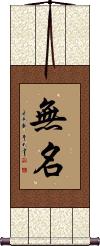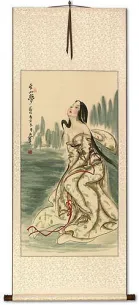Many custom options...
And formats...

The name Wu Ming in Chinese / Japanese...
Buy a Wu Ming calligraphy wall scroll here!
Wu Ming / Anonymous
無名 is a Chinese, Japanese and Korean word that means nameless, obscure, unnamed, anonymous, unsigned, unknown, not famous, and sometimes unjustifiable.
The romanized title, Wu Ming, has been used for several different things such as a group of Italian writers, and even as the Chinese name of the infamous hackers.
This in-stock artwork might be what you are looking for, and ships right away...
Gallery Price: $200.00
Your Price: $79.88
Gallery Price: $200.00
Your Price: $79.88
Gallery Price: $79.00
Your Price: $43.88
Not the results for wu ming that you were looking for?
Below are some entries from our dictionary that may match your wu ming search...
| Characters If shown, 2nd row is Simp. Chinese |
Pronunciation Romanization |
Simple Dictionary Definition |
明 see styles |
míng ming2 ming mei / me めい |
More info & calligraphy: Light / Bright(1) (ant: 暗) brightness; (2) discernment; insight; an eye (for); (3) (See 明を失う) eyesight; vision; (prefix) (4) (abbreviation) (See 明治) nth year in the Meiji era (1868.9.8-1912.7.30); (surname) Meishuu vidyā, knowledge. ming means bright, clear, enlightenment, intp. by 智慧 or 聰明 wisdom, wise; to understand. It represents Buddha-wisdom and its revelation; also the manifestation of a Buddha's light or effulgence; it is a term for 眞言 because the 'true word' can destroy the obscurity of illusion; the 'manifestation' of the power of the object of worship; it means also dhāraṇīs or mantras of mystic wisdom. Also, the Ming dynasty A. D. 1368-1644. |
鬼 see styles |
guǐ gui3 kuei oni(p); ki おに(P); き |
More info & calligraphy: Ghost Demon(1) ogre; demon; oni; (2) (See 亡魂) spirit of a deceased person; (3) (おに only) ogre-like person (i.e. fierce, relentless, merciless, etc.); (4) (おに only) (See 鬼ごっこ・おにごっこ) it (in a game of tag, hide-and-seek, etc.); (5) (き only) {astron} (See 二十八宿,朱雀・すざく・2) Chinese "ghost" constellation (one of the 28 mansions); (prefix) (6) (おに only) (slang) (See 超・1) very; extremely; super-; (surname) Miniwa preta 薜荔多, departed, dead; a disembodied spirit, dead person, ghost; a demon, evil being; especially a 餓鬼 hungry ghost. They are of many kinds. The Fan-i ming i classifies them as poor, medium, and rich; each again thrice subdivided: (1) (a) with mouths like burning torches; (b) throats no bigger than needles; (c) vile breath, disgusting to themselves; (2) (a) needle-haired, self-piercing; (b) hair sharp and stinking; (c) having great wens on whose pus they must feed. (3) (a) living on the remains of sacrifices; (b) on leavings in general; (c) powerful ones, yakṣas, rākṣasas, piśācas, etc. All belong to the realm of Yama, whence they are sent everywhere, consequently are ubiquitous in every house, lane, market, mound, stream, tree, etc. |
信心銘 信心铭 see styles |
xìn xīn míng xin4 xin1 ming2 hsin hsin ming Shinjin mei |
More info & calligraphy: Xin Xin Ming / Shinjinmei |
西遊記 西游记 see styles |
xī yóu jì xi1 you2 ji4 hsi yu chi saiyuuki; seiyuuki / saiyuki; seyuki さいゆうき; せいゆうき |
More info & calligraphy: Journey to the West(1) (work) Journey to the West (classic of Chinese literature); (2) (work) Alakazam the Great (1960 animated film); (3) (work) Monkey (1978-1980 TV series); Monkey Magic; (4) (work) Saiyūki (2006 TV series); (wk) Journey to the West (classic of Chinese literature); (wk) Alakazam the Great (1960 animated film); (wk) Monkey (1978-1980 TV series); Monkey Magic; (wk) Saiyūki (2006 TV series) |
不動明王 不动明王 see styles |
bù dòng míng wáng bu4 dong4 ming2 wang2 pu tung ming wang fudoumyouou / fudomyoo ふどうみょうおう |
More info & calligraphy: Fudo Myo-o / Wisdom King不動尊 Aryacalanatha 阿奢羅曩 tr. 不動尊 and 無動尊 and Acalaceta, 阿奢囉逝吒 tr. 不動使者. The mouthpiece or messenger, e. g. the Mercury, of the Buddhas; and the chief of the five Ming Wang. He is regarded as the third person in the Vairocana trinity. He has a fierce mien overawing all evil spirits. He is said to have attained to Buddhahood, but also still to retain his position with Vairocana. He has many descriptive titles, e. g. 無量力神通無動者; 不動忿怒王, etc. Five different verbal signs are given to him. He carries a sharp wisdom-sword, a noose, a thunder-bolt. The colour of his images is various—black, blue, purple. He has a youthful appearance; his hair falls over his left shoulder; he stands or sits on a rock; left eye closed; mouth shut, teeth gripping upper lip, wrinkled forehead, seven locks of hair, full-bodied, A second representation is with four faces and four arms, angry mien, protruding teeth, with fames around him. A third with necklaces. A fourth, red, seated on a rock, fames, trident, etc. There are other forms. He has fourteen distinguishing symbols, and many dharanis associated with the realm of fire, of saving those in distress, and of wisdom. He has two messengers 二童子 Kimkara 矜羯羅 and Cetaka 制吒迦, and, including these, a group of eight messengers 八大童子 each with image, symbol, word-sign, etc. Cf. 不動佛. |
宬 see styles |
chéng cheng2 ch`eng cheng |
(literary) archive room; library (esp. in the imperial palace in the Ming and Qing dynasties) |
一念 see styles |
yī niàn yi1 nian4 i nien ichinen いちねん |
(1) determined purpose; (2) {Buddh} an incredibly short span of time (i.e. the time occupied by a single thought); (3) {Buddh} (See 浄土宗) a single repetition of a prayer (esp. in Jodo-shu); (personal name) Kazune A kṣaṇa, or thought; a concentration of mind; a moment; the time of a thought, of which there are varying measurements from 60 kṣaṇa upwards; the Fan-yi-ming-yi makes it one kṣaṇa. A reading. A repetition (especially of Amitābha's name). The Pure-land sect identify the thought of Buddha with Amitābha's vow, hence it is an assurance of salvation. |
一明 see styles |
yī míng yi1 ming2 i ming kuniharu くにはる |
(given name) Kuniharu ming (i.e. bright, clear, illuminating) is the Shingon word for a dhāraṇī, or magical formula; especially applied to a magical acts. |
五山 see styles |
wǔ shān wu3 shan1 wu shan gosan; gozan ごさん; ござん |
(rare) five most important temples of a region; (surname) Goyama Five mountains and monasteries: (1) in India, sacred because of their connection with the Buddha: 鞞婆羅跋怒 Vaibhāra-vana; 薩多般那求呵 Saptaparṇaguhā; 因陀羅勢羅求呵 Indraśailaguhā; 薩簸恕魂直迦鉢婆羅 Sarpiṣ kuṇḍikā-prāgbhāra; 耆闍崛 Gṛdhrakūṭa; (2) in China, established during the Five Dynasties and the Southern Sung dynasty, on the analogy of those in India; three at Hangzhou at 徑山 Jingshan, 北山 Beishan, and 南山 Nanshan and two at Ningbo at 阿育王山 King Aśoka Shan and 太白山 Taiboshan. Later the Yuan dynasty established one at 全陵 Chin Ling, the 天界大龍翔隻慶寺 which became chief of these under the Ming dynasty. |
代宗 see styles |
dài zōng dai4 zong1 tai tsung daisou / daiso だいそう |
Daizong, temple name of seventh Ming emperor Jingtai 景泰[Jing3 tai4] (personal name) Daisou |
侍郎 see styles |
shì láng shi4 lang2 shih lang jirou / jiro じろう |
(Ming and Qing dynasties) vice-minister of one of the Six Boards; (also an official title in earlier dynasties) (male given name) Jirou |
元史 see styles |
yuán shǐ yuan2 shi3 yüan shih motofumi もとふみ |
History of the Yuan Dynasty, twenty third of the 24 dynastic histories 二十四史[Er4 shi2 si4 Shi3], compiled under Song Lian 宋濂[Song4 Lian2] in 1370 during the Ming Dynasty, 210 scrolls (personal name) Motofumi |
刑名 see styles |
xíng míng xing2 ming2 hsing ming keimei / keme けいめい |
xing-ming, a school of thought of the Warring States period associated with Shen Buhai 申不害[Shen1 Bu4hai4]; the designation for a punishment penalty designations |
制錢 制钱 see styles |
zhì qián zhi4 qian2 chih ch`ien chih chien |
copper coin of the Ming and Qing Dynasties |
劉基 刘基 see styles |
liú jī liu2 ji1 liu chi |
Liu Ji or Liu Bowen 劉伯溫|刘伯温[Liu2 Bo2 wen1] (1311-1375), general under the first Ming emperor Zhu Yuanzhang 朱元璋[Zhu1 Yuan2 zhang1], with a reputation as a military genius |
南苑 see styles |
nán yuàn nan2 yuan4 nan yüan nanen なんえん |
Nanyuan or "Southern Park", an imperial hunting domain during the Yuan, Ming and Qing Dynasties, now the site of Nanhaizi Park in the south of Beijing (given name) Nan'en |
南藏 see styles |
nán zàng nan2 zang4 nan tsang Nanzō |
The Southern Collection, or Edition, of the Chinese Buddhist Canon, published at Nanking under the reign of Tai Tsu, the first emperor of the Ming dynasty, who reigned A.D. 1368-1398. |
唐寅 see styles |
táng yín tang2 yin2 t`ang yin tang yin touin / toin とういん |
Tang Bohu 唐伯虎 or Tang Yin (1470-1523), Ming painter and poet, one of Four great southern talents of the Ming 江南四大才子 (personal name) Touin |
土司 see styles |
tǔ sī tu3 si1 t`u ssu tu ssu |
sliced bread (loanword from "toast"); government-appointed hereditary tribal headman in the Yuan, Ming and Qing dynasties |
增生 see styles |
zēng shēng zeng1 sheng1 tseng sheng |
(medicine) hyperplasia; (abbr. for 增廣生員|增广生员[zeng1guang3 sheng1yuan2]) a scholar studying for the Ming dynasty imperial examinations who did not make the quota for support in the form of a monthly allowance of rice that students who made the quota received |
多齡 多龄 see styles |
duō líng duo1 ling2 to ling Tarei |
(多齡路迦也吠闍也); 帝隷 etc. Trailokyavijaya, one of the 明王 Ming Wang, the term being tr. literally as 三世降 (明王) the Ming-Wang defeater (of evil) in the three spheres. |
天順 天顺 see styles |
tiān shùn tian1 shun4 t`ien shun tien shun |
Tianshun Emperor, reign name of eighth Ming Emperor 朱祁鎮|朱祁镇[Zhu1 Qi2 zhen4] (1427-1464), reigned 1457-1464, temple name Yingzong 英宗[Ying1 zong1] |
奢香 see styles |
shē xiāng she1 xiang1 she hsiang |
She Xiang (c. 1361-1396), lady who served as Yi ethnic group leader in Yunnan in early Ming times |
姚明 see styles |
yáo míng yao2 ming2 yao ming |
Yao Ming (1980-), retired Chinese basketball player, played for CBA Shanghai Sharks 1997-2002 and for NBA Houston Rockets 2002-2011 |
孝廉 see styles |
xiào lián xiao4 lian2 hsiao lien |
xiaolian, two examination subjects in Han, later a single subject in Ming and Qing; successful second degree candidate |
宋濂 see styles |
sòng lián song4 lian2 sung lien |
Song Lian (1310-1381), Ming dynasty writer, historian and politician |
宣德 see styles |
xuān dé xuan1 de2 hsüan te |
Xuande Emperor, reign name of fifth Ming emperor Zhu Zhanji 朱瞻基[Zhu1 Zhan1 ji1] (1398-1435), reigned 1426-1436, temple name 明宣宗[Ming2 Xuan1 zong1] |
寶船 宝船 see styles |
bǎo chuán bao3 chuan2 pao ch`uan pao chuan |
Chinese treasure ship, a type of large sailing ship in the fleet of Ming dynasty admiral Zheng He 鄭和|郑和[Zheng4 He2] |
封疆 see styles |
fēng jiāng feng1 jiang1 feng chiang |
border region; regional general acting as governor (in Ming and Qing times) |
山家 see styles |
shān jiā shan1 jia1 shan chia yamaga; sanka やまが; さんか |
mountain villa; house in the mountains; mountain retreat; (surname) Yanbe The 'mountain school', the ' profounder ' interpretation of Tiantai doctrines developed by 四明 Ssu-ming; v. last entry. |
Click here for more wu ming results from our dictionary
The following table may be helpful for those studying Chinese or Japanese...
| Title | Characters | Romaji (Romanized Japanese) | Various forms of Romanized Chinese | |
| Wu Ming Anonymous | 無名 无名 | mu mei / mumei | wú míng / wu2 ming2 / wu ming / wuming | |
| In some entries above you will see that characters have different versions above and below a line. In these cases, the characters above the line are Traditional Chinese, while the ones below are Simplified Chinese. | ||||
Successful Chinese Character and Japanese Kanji calligraphy searches within the last few hours...








